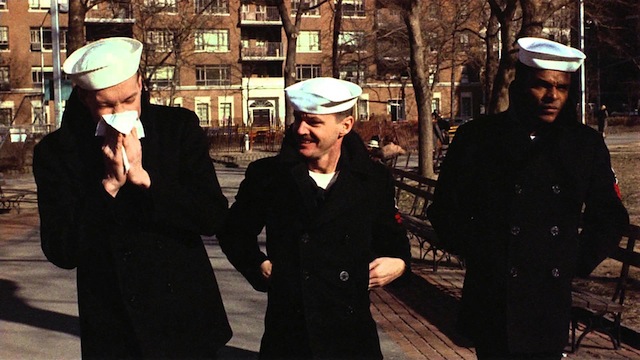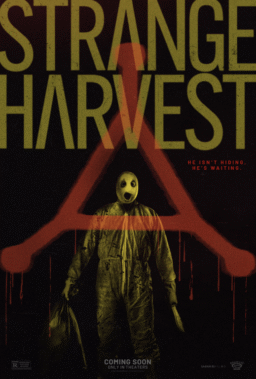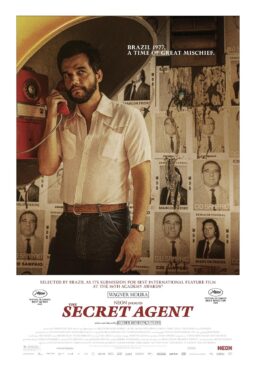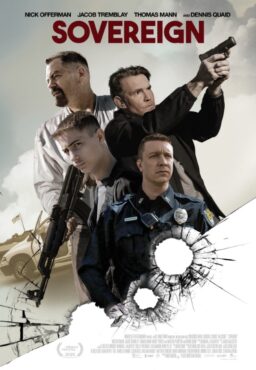There’s a single cut in Hal Ashby’s “The Last Detail” that best captures the film’s benevolent worldview.
With only 90 minutes left before they have to be at the Portsmouth Naval Prison, First Class Billy “Badass” Buddusky (Jack Nicholson) and Gunner’s Mate First Class Richard “Mule” Mulhall (Otis Young) ask their 18-year-old charge Seaman Larry Meadows (Randy Quaid) what he wants to do with his remaining time. Buddusky and Mule have been assigned a detail escorting Meadows to prison where he’ll serve an eight-year sentence for stealing $40 from a charity collection box. The two Navy lifers believe the punishment to be unjust, so they decide to show the kid a good time before sending him to the brig. At the end of their five-day trip, they have gotten Meadows drunk, stoned, and laid. He’s brawled with Marines, chanted with Buddhists, and eaten the world’s finest Italian sausage sandwiches. What’s there left to do?
As the men walk down a brumal Boston street and mull their options, Buddusky mentions that it’s a shit day outside. Meadows responds that if it was summer they could maybe have a picnic. The film then jump cuts to Buddusky struggling to break sticks with his feet in a snow covered park as Mule, shivering and hunched over, tries to light a fire in a public grill.
The production team’s collective powers—Ashby’s understated direction; Michael Chapman’s stark photography; Robert Jones’ jigsaw-like editing schema; and, of course, the three main players working at the height of their careers—peak in that one moment. “The Last Detail” presents a petty, obdurate military bureaucracy that subsists on keeping their men frustrated and trapped while fighting an immoral war. Institutions can’t be trusted because they only serve to perpetuate their own existence rather than serve the people. It’s only individuals within those systems that are capable of extending compassion and generosity to their fellow man.
Not long after their makeshift picnic, Meadows tries to flee and receives an unceremonious beating from his new friends. But before then, there’s a brief moment when two sailors, knowing what a naïve kid will inevitably endure in a Marine barracks and feeling guilty about their part in his suffering, roast hot dogs (without buns) in the dead of winter to honor their soon-to-be departed friend. It’s a flash of kindness in an unfeeling world

In the early ’60s, sailor Darryl Ponicsán served temporary duty as “assistant to the career guidance counselor” on the USS “Intrepid.” In order to whittle away their endless free time, Ponicsán and the head counselor would play chess and swap stories. The counselor told him about his time as a prison escort where he and another sailor were assigned to cart off an 18-year-old to the brig for stealing from a collection box. Not long after hearing the story, Ponicsán started writing the beginnings of his debut novel “The Last Detail.”
Ponicsán left the Navy in 1965. He was a social worker in Watts and then taught high school English, working on the novel in the summers. In the summer of 1969, he took a creative writing course taught by Pulitzer Prize-nominated writer Wirt Williams, another former sailor. For one class exercise, Ponicsán rewrote the opening of “The Last Detail” from memory. Impressed by the work, Williams eventually passed along Ponicsán’s unfinished manuscript to his agent, who quickly sold the book and then the film rights to Columbia Pictures.
Written by Robert Towne, “The Last Detail” suffered numerous production difficulties before it made to theaters. Columbia balked at the profanity in Towne’s script, frequently demanding it to be toned down in pre- and post-production to no avail. The studio was also suspicious of Ashby, who had a reputation for rebellion and ill communication; their distrust was further exacerbated when he was arrested for marijuana possession while scouting locations in Canada. (Nicholson’s involvement was largely responsible for the film’s survival). Rupert Crosse was originally supposed to play Mule, but his terminal cancer diagnosis forced him to drop out of production at the last minute; he died nine months before the film’s premiere. During the editing process, the studio tried to take the film away from Ashby due to delays, but was eventually mollified.
Producer Gerald Ayers convinced Columbia to submit “The Last Detail” to Cannes where Nicholson won Best Actor. Upon its eventual wide release in the spring of 1974, the film received positive reviews and netted three Oscar nominations. Over 30 years later, “The Last Detail” stands as one of the high watermarks of the New Hollywood era, not to mention career-best work from Ashby and Nicholson.
In 2005, under pressure from his friend and former Paramount executive Tom wright, and in the shadow of the burgeoning Iraq War, Ponicsán wrote “Last Flag Flying,” a sequel to “The Last Detail.” The novel catches up with middle-aged versions of Buddusky, Mule, and Meadows in the winter of 2003, around the time when Saddam Hussein was captured by American forces. Meadows recruits his two old friends to help him bury his son, who enlisted in the Marines and died in Baghdad. Though Meadows was told his son died in an ambush, he learns that he was actually shot in the back of the head while retrieving Cokes from a local bodega. Distrustful of the government, Meadows impulsively decides to forgo an Arlington burial in favor and take the body back home for a civilian funeral. Buddusky and Mule tag along for the long road home.
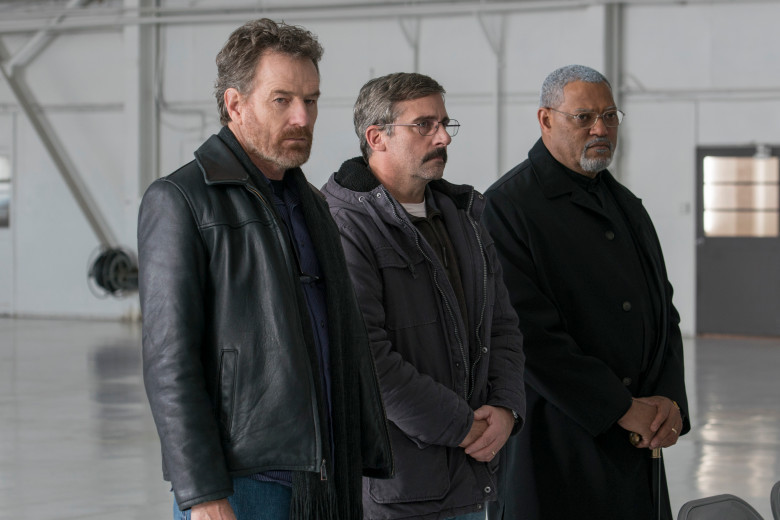
This week, Richard Linklater’s adaptation of “Last Flag Flying” will open in wide release. The film operates as a rough “spiritual sequel” to “The Last Detail,” similar to the relationship between Linklater’s “Everybody Wants Some!!” and its forbearer “Dazed and Confused.” Linklater and Ponicsán co-wrote the screenplay and made a handful of major changes to the source material to avoid comparison between the two films. The three character names have been changed (Buddusky becomes Sal, Mule becomes Mueller, and Meadows becomes Doc), along with their service record (they’re former Marines instead of former Navy men), and their origin story (Doc went to jail over some missing morphine, taking the fall for Sal and Mueller who were abusing the drug during Vietnam). It’s not necessary to see “The Last Detail” to understand “Last Flag Flying.” The two function as a rhyming couplet across alternate dimensions.
Yet, the films share two key qualities that provide some gravity to “Last Flag Flying.” First, there’s the directors’ approach to the material; Ashby and Linklater aren’t visual siblings necessarily, but they share a certain sensitivity towards actors, allowing them to suss out great performances from them, and the ability to elevate small moments to a higher, emotionally potent plane. Second, the films share a thematic affinity that’s difficult to ignore: the ideological ambivalence that comes from serving a country that lacks a moral compass. In both films, the three men are caught between values like honor, duty, and justice—ideas drilled into them by military service—and their own cynicism, bordering on utter disdain, for the larger system. The wars might change but the struggle remains the same.
“Though it is not a theme in ‘The Last Detail,’ the Vietnam War is on every page,” says Ponicsán in a new forward to the re-release of his debut novel. This also applies to Ashby’s film, which mainly adapted the three most crucial elements from Ponicsán’s novel—plot, atmosphere, and vernacular—to the big screen. But while Ponicsán and Towne’s focus stays squarely with Meadows’ predicament and Buddusky and Mule’s guilt, the contradictory emotions regarding patriotism and service are on full display.
In the film, Buddusky and Mule’s lifer status in the Navy doesn’t engender any pride for their country. Instead, their feelings manifest somewhere between world-weariness and outright contempt towards their station. Mule describes their prison escort assignment as a “fucking chickenshit detail” and he’s not wrong. It’s another in a long line of thankless tasks that they’ve been forced to do at the behest of superiors. However, when Buddusky wants to break SOP to inject some life into Meadows before his time, Mule plays the Navy card through and through. They have a responsibility to bring their prisoner to the jailhouse, he insists.
Yet, neither of them is exactly comfortable with their mission. Buddusky, whose “Badass” nickname derives from his penchant for thumbing his nose at authority, especially sees the unfairness of Meadows’ punishment, a harsh sentence handed down only because he stole from his CO’s wife’s favorite charity. He sees the unfettered cruelty of it at all with clear eyes. His brief excursion with Meadows functions as an act of mercy more than anything.
There’s little recourse for them to channel their frustration. All he and Mule can do is complain. When the Marine officer at the barracks chews the two of them out for inflicting a head wound on Meadows, one he sustained after he tried to escape, they mostly take the abuse. Buddusky, the big-game talking, no-nonsense sailor with an endless supply of earthy wisdom, is forced to kiss the boots of a man he doesn’t respect. They only put their foot down when the officer notices that their orders were never officially signed, which effectively means they never “left” their post. “But we’re standing right here,” Mule complains when the Marine tries not to sign off on their assignment. He only relents when the two demand to see his Executive Officer. Their only leverage requires appealing to another officer’s generosity in the expansive military food chain.
Neither Ashby nor Towne explicates how Meadows’ situation stands as a microcosm of the war effort, but it reverberates in Chapman’s muted, bleak photography, the bureaucratic shenanigans, and, yes, the profanity, which is symbolic of the lifers’ powerlessness. Buddusky and Mule embark on hubristic, unjust mission that only reflects their leaders’ vindictive, deceptive nature. But they do it anyway, willfully choosing to be forever caught between their allegiance and their bone-deep skepticism. When asked by a hippie how he felt about going to Vietnam, Mule shrugs and says, “The man says go. You gotta do what the man says. We’re living in this man’s world, ain’t we?” Indifference towards active military service has rarely felt more weary and programmatic.

For “Last Flag Flying,” Linklater adopts a more openly ruminative approach to these same ideas. Though this tactic occasionally falls into didacticism and aphoristic speechifying, it not only befits Ponicsán’s novel but also the characters’ middle-aged reflective attitudes. The men may have moved on from their time in the service—Sal opened a bar, Mueller became a preacher, and Doc started a family—but the specter of Vietnam hasn’t left their hearts and minds.
In 2003, America embarked on another multi-billion dollar war under false pretenses and shoddy intelligence, only this time a media blackout shielded U.S. citizens from seeing the human cost of their government’s arrogance. As embellishments, falsehoods, and egregious lies trickle down from the mouths of leaders to the masses below, unvarnished truth becomes a valuable commodity. But when does the truth stop being a lifejacket and start being an anchor? In turn, when does a lie become convenient enough to serve as a replacement for the truth?
These are just a couple of questions at the heart of “Last Flag Flying,” but Linklater and Ponicsán’s commitment to their characters’ internal contradictions all but precludes them from definitive answers. Colonel Wilits (Yul Vasquez) tells Doc that his son, Larry Jr., died a hero in Baghdad, but Larry Jr.’s fellow Marine Washington (J. Quinton Johnson) relay to Sal and Mueller the sad, unceremonious truth about his demise. Sal, a man who doesn’t believe in the power of convenient lies, insists on telling Doc what really happened, but Mueller suggests that they should give Doc the courtesy of remembering his son as a hero. Sal wins out, and Doc shoulders even more pain as he turns his back on the government.
As the three men take the long train back to Doc’s hometown, with Washington as an official military escort by their side, the men bond over shared service and bawdy stories. Yet, they keep circling back to their shared skepticism regarding their country’s stated intentions. The young, stoic Washington parrots similar official rhetoric that the veterans all heard during Vietnam. They express disappointment and anger at lost lives and unjust causes. The senselessness of it all makes them shake their heads and roll their eyes. Same as it ever was.
But Linklater and Ponicsán plunge into morally murkier territory in “Last Flag Flying” by suggesting that some lies, even those told by the government out of self-preservation, are better than the ugly truth. Throughout the trip, Sal needles Mueller and Doc about the time when their morphine addiction contributed to a young man’s painful death on the battlefield. Sal insists that they seek out the soldier’s mother (Cicely Tyson) and finally confess their sins. But when they arrive, the soldier’s elderly mother believes that they are the men whom her son died saving, another lie she was told by some Colonel long ago. Sal doesn’t have the heart to tell her otherwise.
Meanwhile, the Marines subtly push another lie on Doc that goes entirely unnoticed. Though Colonel Wilits tells the veterans that he’s sending along Washington only as an escort, he’s also there as a representative of the Corp to make sure that Larry Jr. is buried in his uniform. Doc wants him buried in his high school graduation so he won’t be forever tied to the strings of the military, a choice that doesn’t sit well with the military brass. Eventually, Doc relents with little to no prodding from Washington at all when Sal insists that the uniform doesn’t have to represent anything more than his son’s noble actions outside of the larger injustice. Sal, a man with no love for the Marines, helps score another win for the Corp entirely by accident.
Linklater and Ponicsán punctuate the proceedings with small ironies, as if the military’s nasty humor follows them around like the plague. Contradictions are never resolved, emotions never quelled, and relief doesn’t fully arrive. Indeed the most powerful moment comes at Larry Jr.’s funeral when Sal and Mueller in full dress uniform present a folded flag to Doc. Sal tells him, “Kid, I don’t know how grateful the nation is, or how much the president might regret your loss, but here’s your country’s flag.” It’s a gentle reminder of what that symbol might have meant to his son, a young man who completely believed in its promise up until his untimely death.
If there’s one thing that “Last Flag Flying” painfully lacks, it’s brief moments like the hard cut to the winter picnic in “The Last Detail” that encapsulate a range of emotions. “Last Flag Flying” ultimately errs on the side of convention, and it’s easy to tell when Linklater’s digressive, hangout style clashes with the demands of the narrative. However, he still manages to imbue his film with those flashes of kindness that made Ashby’s feature a melancholic staple. In Sal and Mueller, Linklater presents a humanist obligation to make sure their fellow man doesn’t bury his boy alone. By the end of the film, they stand next to him during a particularly grief-stricken moment, and are simply available if necessary. The government may have abdicated their moral responsibility to guarantee children don’t die in unjust wars, but citizens uphold their basic civic duty by helping pick up the pieces from their mess. Ideological ambivalence will forever be upheld as long as the country retreads the same questionable ground. It’s the present kindness that won’t fade away.

